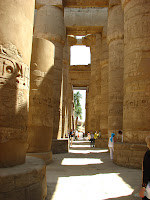Karnak Temple is shaped like any other Ancient Egyptian temple, in the shape of a human body where the head is the inner sanctuary for t
 he god/dess and houses the sacred statue. Though being at Karnak, one has a hard time envisioning the start and end of the temple complex, for it sprawls like a megamall across the landscape. One of the most striking parts of Karnak was that it was my first temple, and where most of the Egyptian artefacts at museums are sadly without color, every once in a while turquoise, lapis and golden body parts pop out from behind columns, giving a glimpse of what this place must have looked like long ago. Two large obelisks are all that remain of the original six that went here before. A dried up harbor is evident, which was once used to float in statuary. But still, even with this beauty, the touch of tourism reigns surpreme. As we watched egrets pick their way across sandstone steps, guards filled the sacred lake from a large hose and gatorade could be purchased across the walkway for the equivalent of 40 LE (almost $8). On the other hand, there was little to deny the power of this place, and everywhere you were meant to feel small from the gaping doorways to the larger-than-life statues, hieroglyphics, columns that stretched towards the sky. Even walking once around the sacred scarab statue for good luck made me wonder how many people had gone before me.
he god/dess and houses the sacred statue. Though being at Karnak, one has a hard time envisioning the start and end of the temple complex, for it sprawls like a megamall across the landscape. One of the most striking parts of Karnak was that it was my first temple, and where most of the Egyptian artefacts at museums are sadly without color, every once in a while turquoise, lapis and golden body parts pop out from behind columns, giving a glimpse of what this place must have looked like long ago. Two large obelisks are all that remain of the original six that went here before. A dried up harbor is evident, which was once used to float in statuary. But still, even with this beauty, the touch of tourism reigns surpreme. As we watched egrets pick their way across sandstone steps, guards filled the sacred lake from a large hose and gatorade could be purchased across the walkway for the equivalent of 40 LE (almost $8). On the other hand, there was little to deny the power of this place, and everywhere you were meant to feel small from the gaping doorways to the larger-than-life statues, hieroglyphics, columns that stretched towards the sky. Even walking once around the sacred scarab statue for good luck made me wonder how many people had gone before me.Two and a half miles away from Karnak is Luxor Temple, once connected by two and a half miles of sphinxes. We visited this temple at night in order to see both its beauty by daytime and how it looked touched by the setting sun. One of the only statues of Tut Ankh Amun is here, an alabaster
 giant, where he sits comfortably with his girl-wife. There is also a 7th-century Arabic mosque on the site, the door rests high above the ground, a testament to the sand that once took over the grounds. Only one obelisk remains here - the other is in Paris, a gift from Egypt. In return, the Egyptians accepted a broken cloc
giant, where he sits comfortably with his girl-wife. There is also a 7th-century Arabic mosque on the site, the door rests high above the ground, a testament to the sand that once took over the grounds. Only one obelisk remains here - the other is in Paris, a gift from Egypt. In return, the Egyptians accepted a broken cloc k (which is still broken). Many of the statues and carvings have been destroyed here, but in different styles: the Christians defaced the statues, and the Arabs beheaded them. The heads of some of the beheaded statues have been found, sadly, the defaced statues are ruined forever. Even worse is the creation of Christian murals over the Egyptian carvings in the inner sanctuary, the colors standing vivid and proud against the defacements below.
k (which is still broken). Many of the statues and carvings have been destroyed here, but in different styles: the Christians defaced the statues, and the Arabs beheaded them. The heads of some of the beheaded statues have been found, sadly, the defaced statues are ruined forever. Even worse is the creation of Christian murals over the Egyptian carvings in the inner sanctuary, the colors standing vivid and proud against the defacements below.Once these two temples stood as testament to Egyptian power and influence, and I don't think there is any doubting that in their own way, they do so still.
Stay Tuned for the Valley of the Kings

No comments:
Post a Comment